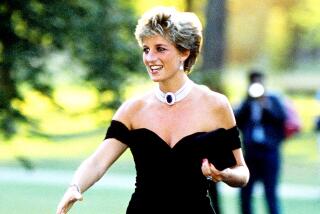And the Bride Wore... : Pasadena Historical Perspective of Bridal Gowns Stirs Memories, Spins Dreams of Happily Ever After
In 1939, Evelyn Kyle carefully donned her wedding veil--its crown fashioned from orange blossoms and her great-grandmother’s handkerchief--and walked down the aisle.
Recently, the 79-year-old woman took the fragile headpiece from the cedar chest where it had been for more than five decades and strolled down memory lane.
“It reminded me of when we were young and in college, and of course, of our wedding day,” said Kyle, who donated the veil to the Pasadena Historical Society for its summer exhibit: “And the Bride Wore . . . “
The exhibit at Fenyes Mansion, where the Historical Society is based, is a collection of 12 wedding gowns worn by brides from 1856 through the 1960s. The gowns will be on display until the end of the month.
Kyle wasn’t the only one to relive her wedding day. Several of the Historical Society’s docents donated their wedding gowns to the exhibit as well.
Cecilia Mathews, 86, was married in 1924, and her cream-colored dropped-waist dress typified the flapper era. “My mother made this dress for me,” said Mathews as she eyed the lacework on the hemline. “She just looked in Vogue and picked this dress out.”
For Patricia Hammerle, finding the perfect wedding dress was not so easy.
It was 1945, and fabric was scarce because of the war. So the Pennsylvania native combed through stores before finding the traditional, long white satin gown she ultimately wore.
“I was delighted to find this,” said the 70-year-old Hammerle, as she looked at her gown on the mannequin, and then showed off her wedding photograph: bride clutching orchids, groom in military garb.
During World War II, many couples gave up big wedding plans and instead married on weekend furloughs.
“I had a blue wool suit,” recalled Nadine Feldheim, who wed in 1944.
“My husband had seven days off from the service,” said Feldheim, of Covina, as she toured the bridal exhibit on a recent afternoon. “When people got their leaves, they came home and got married. There was no time to plan a big wedding.”
As if to make up for the shortages during the 1940s, wedding gowns of the 1950s were elegant and made from luxurious materials. Typically, these dresses featured tiny waistlines with skirts that billowed over crinoline petticoats or hoop skirts. The 1950s-style dress on display also illustrates the generous use of net and lace that was popular at the time.
“They’re just gorgeous,” said Lou Rodriguez, 22, as she examined each of the dresses. “My favorite is from the 1880s. The dresses from that era were very feminine, very beautiful.”
The gown Rodriguez admired most was an ivory wool serge, with a tight-fitting bodice held in place with bone stays and laced with a silk cord. It also had a three-foot train. “It might be a bit much for California,” Rodriguez conceded, “but I definitely want to get married in a traditional dress.”
Most of the wedding gowns in the show--including a plaid silk taffeta worn in 1856, a bustle-style dress with puffed sleeves worn by a bride in 1869 and a brown silk gown worn by a Pasadena native in 1890--come from the museum’s regular costume collection.
“We thought it would be fun to have a show with just wedding gowns,” said Kim Has, one of the Historical Society’s curators. Has said she donned a simple poncho as part of her ensemble when marrying outdoors in 1984 at Lake Tahoe.
“I didn’t have a traditional wedding at all,” she said. “Every once in a while I wonder if I missed out on something. I see these gowns, and I think it would have been nice to have a gown and to keep it for the memories.”
THE EXHIBIT
“And the Bride Wore . . . ,” an exhibit of bridal finery since the 1850s, will be on display at the Fenyes Mansion, 470 W. Walnut St., Pasadena, through July 31.
The gowns may be viewed on Tuesdays, Thursdays and Sundays from 1 to 4 p.m. There is a $4 admission charge.


